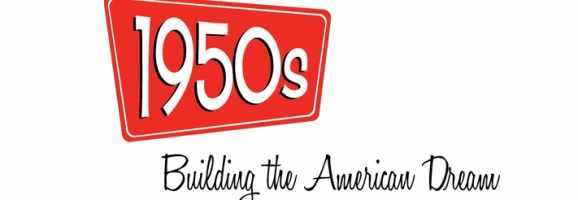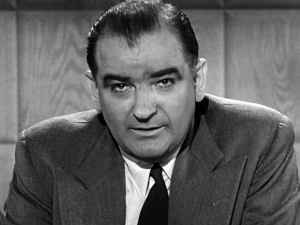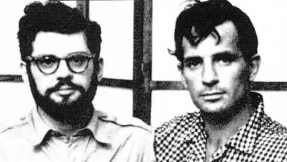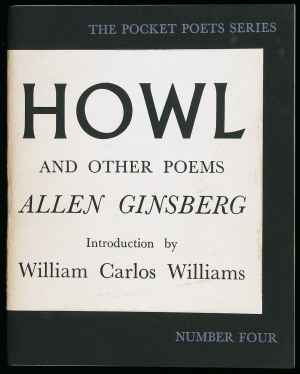Ginsberg’s “Howl” and the Birth of a New Generation of Literature
The 1950s literary scene was ignited by emerging writers who rejected the postwar American culture. Among these writers was Allen Ginsberg, whose poem “Howl” has become one of the most important poems written in the past century. While some hailed it as a work of genius, many deemed it obscene, illustrating the culture it aimed to battle against. The poem rejected the repressive, capitalist, postwar American culture of the 1950s while also representing and illuminating the subculture that would eventually form the ideology of the Beat writers. These writers helped to make possible the counterculture revolution of the 1960s. In order to understand the poem, one must first understand the culture that produced it.

The postwar decade of the ‘50s marked a time of economic expansion for the United States. Men were returning from war, and goods that were previously unavailable were now not only accessible but in high demand. With the economic boom, and technological advances, consumerism was on the rise. Television was becoming a staple of American culture. According to Schmoop, 90% of American households contained at least one television by the end of the ‘50s. This technology was often used as a tool to reiterate the status quo as mass media became dominant in the culture. Gender roles, family structure and expectations were very rigid at this point, which is often illustrated by the idea of the 1950s suburban housewife. In Robert Richman’s “Allen Ginsberg Then and Now,” he explains that “When City Lights published ‘Howl’ in 1956 [Ginsberg] wished it known that the book contained not just poems but contraband goods-dangerous to buy and dangerous to consume.” He understood the exploitive nature of 1950s America, and predicted opposition to his work. The decade is often seen as an era of conformity, but also, to a much lesser extent, of rebellion–thanks to writers like Ginsberg.
The writers of the 1950s had lived through the horrors of WWII, and were in the midst of the Cold War. Scholar Jeffrey Meyers has described “Howl,” as a “prophetic antiwar poem.” In his essay “Ginsberg’s Inferno: Dante and ‘Howl’” he relates the poem to Dante’s Inferno, as the two poems share much of the same ideology. While Ginsberg never officially named Dante as an influence, he wrote to Kerouc in 1948 explaining that he had been reading him and found his work very inspiring. Meyers explains that, “In the decade before Ginsberg wrote [“Howl”], he’d lived through the atomic bomb, the Cold War, the Berlin Blockade and the Korean War,” and also that “A few years later, in the 1960s, he felt instinctively and saw clearly that the war in Vietnam was disastrous and genocidal.” This would be the source of more politically charged poetry from Ginsberg. The poem has references to the hydrogen bomb, both in section I and II. In section II, while equating objects to Moloch, “monstrous bombs,” are named (line 88). Ginsberg also exclaims, “Boys sobbing in armies! Old men weeping in the parks!” (line 80). Ginsberg is sharing the difficulties that soldiers must face, but also those of their families, who are weeping over their dead sons. Ginsberg also mentions the “crack of doom on the hydrogen jukebox,” (line 15), which is undoubtedly a reference to the hydrogen bomb. The poem refers to pacifists “passing out incomprehensible leaflets,” (line 30). This is a reference to the early anti-war movement, which originated with activists giving leaflets to passerby. Meyers illustrates other parallels to Dante in his essay, the most interesting, perhaps, Ginsberg’s depiction of the eight deadly sins of Dante’s circles of Hell.
The first of the eight deadly signs discussed in Dante’s work is lust. Lust is defined as the craving for pleasures of the body. In Dante’s Inferno, those who have committed this sin are forever blown in hurricane-like winds that are meant to represent their lack of self-control. Lustful behaviors and descriptions can be found in many instances of “Howl.” The poem exalts sexual liberation, and bluntly praises casual sex. Ginsberg refers to Neil Cassady “whoring through Colorado,” and “scattering [his] semen freely.” Sodomy is also considered a sin of lust. Therefore, the homo-erotic references to “cock and endless balls,” and being “fucked in the ass” are examples of lust. The next sin Meyers discusses is gluttony.
Gluttony is defined as over-indulgence to the point of extravagance or waste. Those in this circle of Hell must lie in slush produced by endless icy rain. The slush forces the sinners into a solitary confinement; they cannot see or hear their neighbors. This lonely, icy existence represents the cold, self-indulged attitude they possess. Gluttony is explained not only in terms of overindulgence of food or drink, but of other addictions as well. The repeated sexual references can be interpreted as addiction, and the drug use explored in the poem is certainly an example of gluttony. The line Meyers points out is “cooked rotten animals lung heart feet”; the characters are overindulging, eating every possible part of the animal. The fifth circle of Hell holds those who have practiced wrath.
In Dante’s work, wrath is discussed in terms of rage against one’s self, but also against others. Dante’s River of Styx is home to those who hold anger in their hearts. The wrathful fight each other on the surface while the sullen lie at the bottom of the river. At the bottom of this river, there is only darkness, no happiness or hope. Ginsberg’s poem represents anger in its description of rage against one’s self, and also against the oppressive system. Ginsberg declares that his friends “created great suicidal dramas [by]…jumping off Empire State…[and also] jumped off the Brooklyn Bridge. Violence-the seventh circle-against one’s self is also discussed, as they “danced on broken wineglasses barefoot,” and “cut their wrists…successively.” Dante’s sixth circle of Hell was home to those who had committed heresy, which “Howl” does in almost every sense of the word.
Meyers explains that “’Howl’ defies all conventional, political, social, moral and especially sexual beliefs.” While Dante condemns the behaviors that lead his characters into the circles of Hell, Ginsberg hails them. Heresy can be defined as belief that is in contradiction with orthodox religious doctrine. This poem explores beliefs that are obviously contrary to popular Christian views. Sex and sexual freedom is extensively discussed in the novel, while Christian doctrine forbids sex before marriage, and especially homosexual sex, as it is considered sodomy. Brunetto Latini, a friend of Dante’s, is forced to run ceaselessly as punishment for lustful behaviors. Meyers notes that Ginsberg faintly mirrors this, as many of his friends are constantly and almost obsessively moving back and forth across the nation.
The ninth circle of Dante’s Hell is for those who have committed deceitful and treacherous acts. The circle is divided into four parts, varying in degree of severity. Those punished in this circle are frozen in a lake of ice. Their depth is determined by the severity of their sin, which is marked by who they have deceived. Ginsberg uses Moloch to represent all things treacherous. Moloch is described as a number of things, from small, seemingly unimportant things, to “demonic industries! spectral nations! invincible madhouses!” While Dante absolutely disapproves of these sins, Ginsberg both rejects the culture at large, and celebrates the subculture that has been oppressed by the system. In addition to war, Ginsberg criticizes the American Capitalist system in a time when the United States was in the midst of a second Red Scare.
The second Red Scare occurred after WWII and was fueled by a number of events. The era is often referred to as “McCarthyism,” as Senator Joseph McCarthy was insistent that Communist espionage was rampant in the U.S. This fear stemmed from events such as the Chinese Civil War, the Berlin Blockade and the confessions from high-ranking government officials that they had leaked information to the Soviet Union. The 1953 execution of the Rosenbergs for conspiracy to commit espionage also fueled the growing fear of a Soviet-Communist takeover. These events caused many U.S. citizens to question the state of national security and increased paranoia centered on the Communist Party of the United States of America. The triumph of communist China in the Civil War led to an increased fear of a globalization of communism. An increase in governmental control was the result, as McCarthy often claimed to have access to lists of Communist spies and many who disagreed with his views were accused of being communists, or sympathizers. The scare illustrated America’s repressive government and the value it placed on capitalism. The idea of communism was terrifying to the United States government, as the capitalist economy boomed in the 1950s.

“Howl” rejects consumerism and capitalism at a time when America was profiting greatly from it. Perhaps the most obvious sign of this is the depiction of men burning their money. This is a symbol of absolute rejection of the power of the dollar. Ginsberg’s mother Naomi was a known and active communist and, as a child, Ginsberg attended many radical left meetings and conventions, which undeniably influenced these views. Ginsberg outrightly rejected capitalism and, though a sympathizer of socialism, also criticized communist dictatorships of his time. The poem contains Marxist references as well. This was undoubtedly a factor in the attempt to censor the work. In Footnote to Howl, Ginsberg writes, “holy the fifth International.” This refers to socialist efforts to create a new Workers’ International. Ginsberg also shares that the best minds of his generation were “protesting the narcotic tobacco haze of Capitalism,” (line 31). The best minds also, “distributed Supercommunist pamphlets in Union Square,” until the police “wailed them down,” (line 32). Ginsberg’s socialist leanings were a source of strain in his relationship with Jack Kerouac, who named the character based on Ginsberg “Carlo Marx” in his novel On the Road. During the Cold War, the threat of socialism was real and imminent. To an audience fearing the globalization of communism, it’s easy to see how the work was regarded as radical and obscene. While the work was originally labeled obscene, it won an obscenity lawsuit, and helped to create a culture that made the uprisings of the 1960s possible.

John Tytell in his essay “Howl’s Echoes,” illustrates that “Allen Ginsberg wasn’t just ahead of his time; he helped create ours.” The transition into the 1960s marked the most drastic change between decades since the economic crash of 1929 halted the flouring 1920s and replaced them with the Great Depression. As Ginsberg won the obscenity trial, it was clear that America was on the way toward a more accepting cultural identity. The boundaries set and adhered to in the conservative 1950s were being pushed, protested and destroyed in the decade that followed. The publication and subsequent success of “Howl” showed the subterraneans that their voice could be heard and illustrated a liberation in the things that could be written, and shared. For the first time, underrepresented groups, such as women, minorities and homosexuals, were speaking out and raising awareness of the unjust conditions they were forced to live in. The 1960s birthed legal abortion, the glass ceiling, the Civil Rights Act and the gay rights movement, which Ginsberg was a prominent figure in.
Ginsberg was one of the first poets to write so openly about homosexuality. The poem details homo-erotic acts and rejects conventional gender norms of the time. In a time when homosexuality was thought to be a disease of the mind, Ginsberg exalted casual sex and “endless cock and balls,” (line 11). Ginsberg’s work gave a voice of empowerment and ownership to the gay community. In addition to his frank writing on homosexual life, Ginsberg was very open about his own sexuality and relationship with long-time lover Peter Orlovsky. He was also once expelled from Cuba for expressing that he found Che Guevara cute. While the Stonewall Riots of 1969 are known as the igniting events of the gay rights movement, Ginsberg is known as a pre-Stonewall gay rights spokesperson, giving a face and hope to the gay community. In addition to gay rights activism, Ginsberg was a leader in the anti-war movement.
Ginsberg continued to write politically charged and anti-war poetry well after the publication of “Howl.” One of his best known anti-war poems, “Wichita Vortex Sutra,” juxtaposes descriptions of the Kanas landscape with media reports on the Vietnam War. In 1968, Ginsberg signed the War Tax Protest pledge, refusing to pay taxes that supported and financed the war. His poetry and lifestyle clearly rejected the militant, nationalistic views in regard to war. The 1960s gave way to charged and dangerous political protests, particularly on college campuses. The 1964 draft resulted in thousands of students burning their draft cards in protest of the war. As American military presence in Vietnam grew stronger, the protests became more frequent, and more radical. Ginsberg is credited with coining the term “flower power,” a slogan used to represent a passive resistance and nonviolent ideology in relation to anti-war protests. These protests, along with the other radical forward-moving organizations, such as the Black Panther Party, helped to further the Free Speech Movement. Because of the political divisions caused by these movements, and the outspoken members of them, the 1960s was an extremely conducive moment for the Beat writers and many other underrepresented voices.
The Beat writers put an image and an ideology to the subculture Ginsberg worked to represent. The group produced writings for the oppressed, those silenced by American culture. The poem includes references to Neal Cassady, Ginsberg’s love interest and muse, and Jack Kerouac. “Howl” helped to show those who lurked beneath the surface of representative American culture, from those “expelled from the academies for crazy” to those who went “whoring through Colorado in myriad stolen night-cars.” The first reference is almost certainly one to his expulsion from Columbia University, which led to his confinement in a mental institution, where he met Carl Solomon, whom the poem is dedicated to. Of the Beats, Tytell says, “Reacting to the stultifying repression of the postwar years, they shared an anarchist suspicion of governmental controls, were socially transgressive and experimental as writers, and interested in forging a new consciousness. Ginsberg was a key figure in promoting that consciousness.” The 1957 obscenity trial illustrates the repressive nature of the culture Ginsberg set out to attack, but his triumph proved a change was underway. This work helped to pave the way for future writers, and allowed the previously unheard voices of the 1950s to dominate the media and literary scene of the 1960s.

The literature of the 1960s reflects the turmoil and chaos taking over the nation at the time. Many writers were more openly discussing social issues such as racism and sexism. With both the Civil Rights and Women’s Rights movements growing, women such as Gwendolyn Brooks and Sylvia Plath began writing about the black experience and the hardships of living in a male-dominated society. Many crucial pieces of feminist texts were written during this period, including work from Gloria Steinem, Kate Millett and Betty Friedan. Ginsberg also influenced more writers to openly discuss and criticize mental institutions. Plath’s The Bell Jar is a semi-autobiographical account of a woman’s mental breakdown and her stay at a psychiatric hospital. Ken Kesey’s One Flew Over the Cuckoo’s Nest is another 1960s novel criticizing the state of the nation’s mental health care facilities in a time in which frontal lobotomies and the like were still performed. It was not until 1963, when President Kennedy signed the Community Mental Health Centers Act that new programs were implemented, strengthening the state of mental institutions in the United States. The decade also allowed for experimentation in writings. Only in this transitional, explorative decade is an author like Kurt Vonnegut not only made possible, but met with such success. Some of the most well-known and most read works of literature were born in the 1960s, including To Kill a Mockingbird and Slaughterhouse-Five.
Allen Ginsberg’s most famous work, “Howl,” has been compared to many great poems preceding it. Tytell said this was the “most overt social commentary since Whitman,” who Ginsberg claimed to have been greatly influenced by. Lynn Michelle Fogel, in her “We Got the Beat: Transcendentalism, Allen Ginsberg’s ‘Howl’ and the Inception of a New, Postmodern Generation” explains that when sitting down to write the poem, “Ginsberg proceeded to accomplish what no other writer since T.S. Eliot had done with ‘The Waste Land’-write a poem that had the capacity to change the American perspective.” The poem has been a source of comfort for those underrepresented in American culture, even through today’s time. The poem shouts an antiwar, anti-consumerist ideology that directly rejects the dominant culture of the time in order to elucidate a vastly unheard subculture. The poem has become an extremely influential and important piece of American literature, and “with more than a million copies printed in the United States, Howl is reportedly the most purchased book of poems in our time,” (Tytell). The poem is still hailed as genius, still taught in classrooms. It seems, even 17 years after his death, Ginsberg lives on.

Works Cited
Anderberg, Bengt Niklas. Dantes Inferno. Göteborg: Zinderman, 1961. Print.
Bloom, Harold. Kurt Vonnegut’s Slaughterhouse Five. Philadelphia: Chelsea House, 2001. Print.
Fogel, Lynn M. “We Got the Beat: Transcendentalism, Allen Ginsberg’s “Howl” and the Inception of a New, Postmodern Generation.” Grad Works:University of South Carolina (n.d.): n. pag. Web.
Kesey, Ken. One Flew over the Cuckoo’s Nest. New York: Viking, 2002. Print.
Meyers, Jeffrey. “Ginsberg’s Inferno: Dante and “Howl”” Spring 46.1 (2012): n. pag. Web.
Plath, Sylvia. The Bell Jar. New York: Harper & Row, 1971. Print.
Richman, Robert. “« Allen Ginsberg Then and Now Commentary Magazine.” Commentary Magazine RSS. N.p., July 1985. Web. 01 Mar. 2014.
Shmoop Editorial Team. “Culture in The 1950s.” Shmoop.com. Shmoop University, Inc., 11 Nov. 2008. Web. 27 Feb. 2014.
“The 1960s-70s American Feminist Movement: Breaking Down Barriers for Women.” Tavaana. N.p., n.d. Web. 24 Apr. 2014.
Tytell, John. “The Chronicle Review.” The Chronicle of Higher Education. The Chronicle, 12 Sept. 2010. Web. 01 Mar. 2014.
Wallace Fowlie, A Reading of Dante’s Inferno, University Of Chicago Press, 1981.
What do you think? Leave a comment.











The Beat Generation, among other things, is synonymous with sexual liberation in the USA, and that is one thing I like about it. And no I do not think that they are intended for pornographic purposes/arousing or whatever, those words reflect the conservative American society of the 1950s and how the Beatniks tried to liberate every youth and finally the Beat Generation gave way to the Counterculture of the 1960s- civil rights movement, free speech movement, feminism movement, stonewall riots and sexual revolution. An interesting milestone in the history of the western poetry. I would advice anyone to finish “Howl” even if you can’t finish the whole book.
I am terribly sorry, but Ginsburg and I guess beat poetry is not for me. I go for the more traditional forms from the non-rebels.
Stunning poetry. When I taught this to my students, their inability to engage Ginsberg led me to reconsider teaching.
Allen Ginsberg became a beacon for the Beat Generation. Legend.
Absolutely, along with Kerouac, a defining aspect of the Beats.
Nice analysis on “Howl.” I’ve read it before but the context you provide textures the poem and makes it more interesting.
Thank you for the comment, I really appreciate it! The poem has so much more meaning and resonates more with me when put into context.
Great article. I don’t usually read poems but recently, I’ve become interested in the Beat Generation after reading half of Jack Kerouac’s “On the Road” which of course along with William S.Burrough’s “Naked Lunch” and Allen Ginsberg’s poem “Howl” are some of the major and defining works of the Beat Generation. I did read several poems in the past but none of them were so intriguing and fantastic as “Howl”. I read it aloud and part 2’s my favorite.
I’m usually not a fan of poetry, either, but I fell in love with Ginsberg after taking a Beat Lit. class my freshman year.
One of my favorite lines in his poem Howl is:
“with mother finally fucked, and the last fantastic book flung out of the tenement window, and the last door closed at 4 AM and the last telephone slammed at the wall in reply and the last furnished room emptied down to the last piece of mental furniture, a yellow paper rose twisted on a wire hanger in the closet, and even that imaginary, nothing but a hopeful little bit of hallucination¬—.”
It all began with Apollinaire. Read “Zone” and burn the Beats.
Random, but I’m curious…do you read them in original French or translated English?
Wonderful article – Ginsberg has a special place in my heart.
Howl was hard enough to understand, so I read it about two times before I could catch on. Poetry can be complex at times, and the message lies in between the lines.
a poem that defined the beat generation.
Still one of my favorite poems of all time. Quite possibly THE rallying cry for the beat generation.
When Ginsberg is not being beautiful, he is deeply moving and sometimes even funny. I love, love, love Ginsberg!
Mine is definitely a minority opinion, but I think Ginsberg is more than somewhat overrated as far as poets go.
I love him. Then, I also love Whitman, by whom he was extremely influenced. After reading Whitman-I read Ginsberg first-I saw a ton of similarities. They’re both battle cries of sorts for this lost, unseen generation. I love that.
Good Article, I’m pretty familiar with Ginsberg and Beat Literature in general. But I have to say I haven’t heard overt comparisons drawn between ‘Howl’ and ‘The Inferno’ before and I found that very interesting and I’ll have to look more into it. From my experience I’ve heard comparisons mostly to Blake when it comes to religiously centered poetry. So it was nice to look at it from another side of that.
Very good article. I am not sure though that culture or its productions could be fully explained by socio-ec onomic references, but they certainly contribute to a better understanding.
I can still remember the first time I read Howl and how it honestly shook me. To this day, I have found few other poems that have really evoked that type of reaction by it’s power and keen word use.
‘Howl’ is probably the greatest poem I’ve ever read. The images he conjures throughout and the vehement anti-capitalist sentiments in the second section will forever stand out to me.